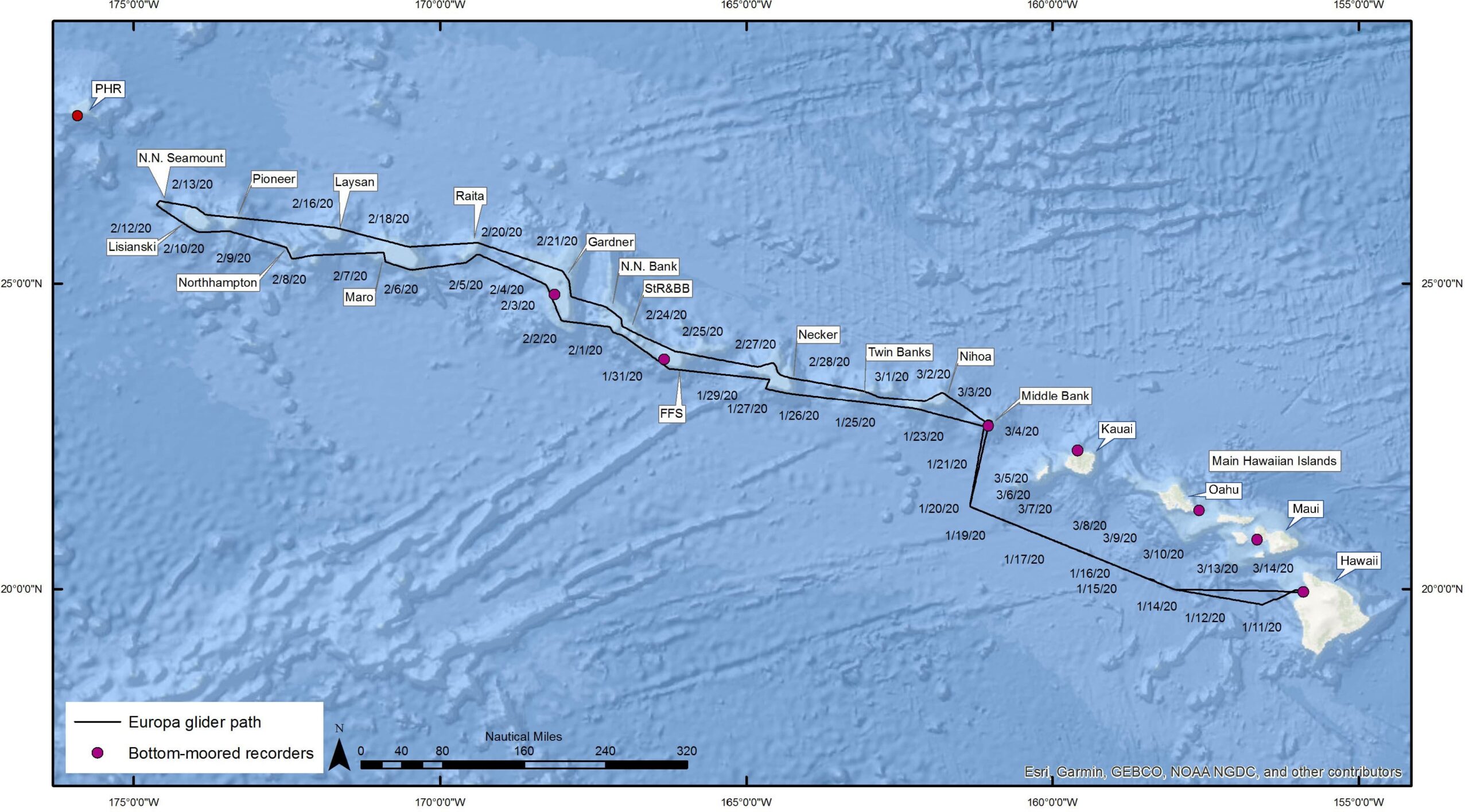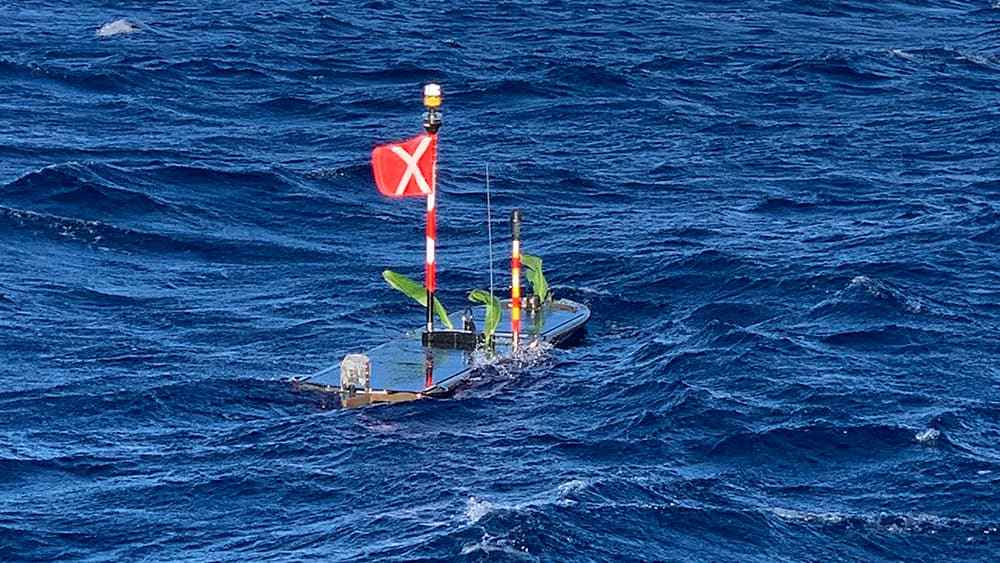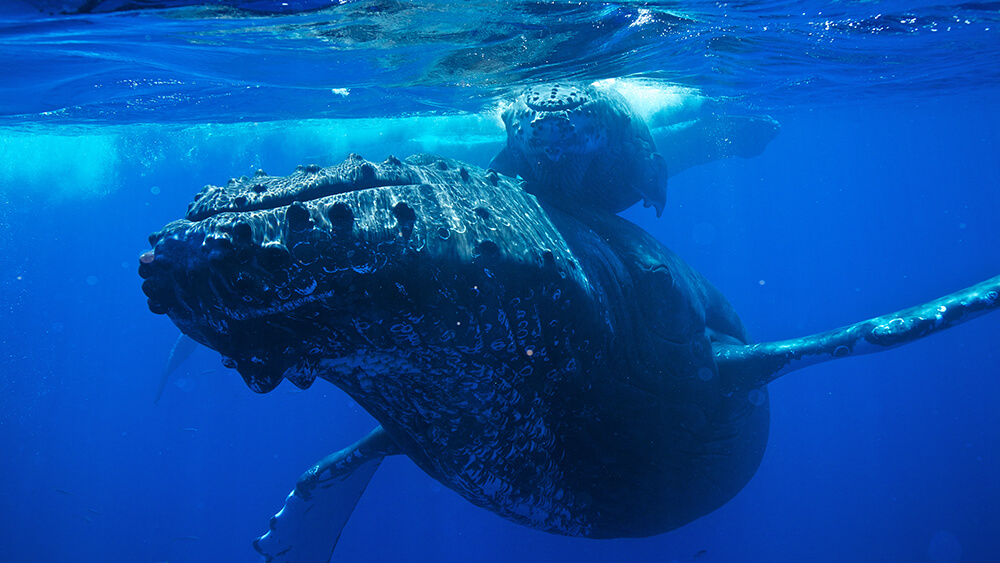Customer
NOAA’s Office of National Marine Sanctuaries, Jupiter Research Foundation, University of Hawaiʻi at Mānoa
Mission Location
Papahānaumokuākea Marine National Monument, Hawaiʻi
Highlights
- Wave Glider travels to remote, large spatial area while collecting acoustic data of humpback whales
- Within 67 days, the Wave Glider traveled 2,600 nautical miles
- New insights gained on humpback whale population(s) migrating to Hawaiian archipelago
“Much like the Mars Rover that was sent to explore in advance of a future manned mission, the Wave Glider has offered us a glimpse of humpback whale presence in Papahānaumokuākea, beckoning us to explore further.”
Large Scale Survey Area
Researchers from NOAA’s Office of National Marine Sanctuaries, the Jupiter Research Foundation, and the University of Hawaiʻi at Mānoa deployed Wave Glider Europa to gain important new insights into the humpback whale population(s) migrating to the Hawaiian archipelago.
Each winter, humpback whales travel from their summer feeding grounds in Alaska to their breeding grounds in Hawaiʻi. The Hawaiian Islands Humpback Whale National Marine Sanctuary
was established around the inhabited, Main Hawaiian Islands to protect this migratory species. Until recently, it was poorly understood whether humpback whales also visit the northwestern part of the Hawaiian archipelago, the Papahānaumokuākea Marine National Monument.
Papahānaumokuākea spans over 580,000 square miles and consists of a chain of small islands, atolls, and banks. Access and conducting research can be challenging due to its remoteness, especially during the winter months when ocean conditions are rougher.

Wave Glider Europa (black line) traveled along the Main Hawaiian Islands to Papahānaumokuākea Marine National Monument while collecting acoustic data. In addition, eight acoustic sensors were moored to the ocean floor. Source: NOAA
Mobile and Fixed Acoustic Recorders
In 2020, the team of researchers equipped a Wave Glider with passive acoustic monitoring (PAM) devices to listen for humpback whale songs. Uncrewed surface vehicles offer an excellent alternative to monitor large areas that are logistically or practically challenging to survey via traditional research vessels. Acoustic surveys are an effective way to detect the presence of whales, and the intensity of whale songs—or the lack thereof—allows for an estimate of the relative abundance of humpback whales in the region.
Wave Glider Europa was launched out of Liquid Robotics’ Marine Operations Center at Kawaihae Harbor, Hawaiʻi Island, and traveled along the Main Hawaiian Islands towards the Northwestern Hawaiian Islands. Wave Gliders are persistent, long-duration uncrewed surface vehicles that can easily accommodate longer transit distances to the study area of interest. Wave Glider Europa surveyed approximately 950 miles of the Hawaiian archipelago, and traveled a total of 2627 nautical miles over 67 days while recording the presence of humpback whales songs.
In addition, passive acoustic monitoring recorders were moored at eight sites during the 2019-2020 breeding season, including locations in the Main Hawaiian Islands and the Northwestern Hawaiian Islands. These were part of NOAA’s and the U.S. Navy’s Sanctuary Soundscape Monitoring Project (SanctSound).

Wave Glider Europa departs to the Northwestern Hawaiian Islands, blessed with ti leaf for a safe journey. Photo credit: NOAA
Presence or Absence?
“Based on recordings of whale song, our research reveals that nearly the entire Hawaiian archipelago is visited by humpback whales during the winter and early spring months,” says Marc Lammers, research ecologist, Hawaiian Islands Humpback Whale National Marine Sanctuary, and lead author of the publication released in Frontiers in Marine Science in January 2023.
A machine learning model was applied to analyze 92,408 minutes of acoustic recordings. Every sampling location within the monument revealed high and sustained seasonal chorusing levels of whale songs. “Song occurrence patterns suggest that there may be more structure in the distribution of whales in Papahānaumokuākea than previously known,” says Lammers. “It raises questions about whether multiple populations occur across the archipelago.”
Worldwide, humpback whales can be classified into 14 distinct population segments with strong fidelity to their migratory destinations. For the Western North Pacific humpback whale population, which is distinct from the Hawaiʻi population, researchers have not yet established the location of all their breeding grounds and the far northwestern end of the monument beyond Gardner Pinnacles could be part of the answer.

Mother and calf humpback whale in Hawaiʻi. Photo credit: Jason Moore/NOAA under NOAA Permit #15240
Management Application
The research findings will inform management decisions, such as permitting and future research within the monument. Additional research is needed to learn more about the humpback whale population(s) visiting Papahānaumokuākea, including photo identification, biopsy samples, and collecting other information.
Other photo credits: Top banner: NOAA; Thumbnail: Jason Moore/NOAA under Permit #14682